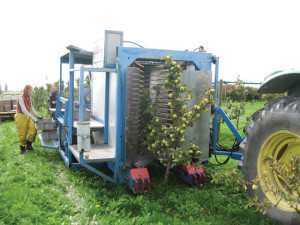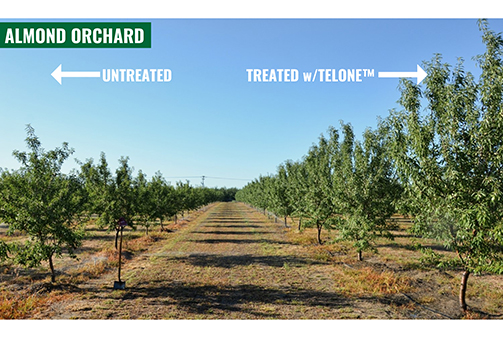Place For Harvesters In Hard Cider

Research at Washington State University is being conducted on a BEI blueberry harvester. This harvester pictured was loaned to Carol Miles and her research team from a local grower. Although it was an older model and was shorter than what would work best for harvesting, Miles and her team found that offloading fruit in the back worked best for the harvest of hard cider apples. (Photo credit: Carol Miles, Washington State University)
In her research, she uses blueberry harvest equipment which is designed to knock fruit off branches. Miles notes that apples that are trellised would allow for a harvester to pass over the trees and knock the fruit off the tree. She quickly acknowledges the advantage that a mechanical harvester would have since bruising is acceptable on apples used in hard cider.
“Our data shows that when we pressed juice of fresh and stored fruit, there was no detrimental difference in quality,” says Miles.
The Research
After early trials involving a raspberry harvester where the fruit comes to the top of the harvest platform, Miles acknowledged that a harvester with fruit offloading in the back of the machine would work best. In 2013, Miles and her research team had hoped to have new configuration of a BEI blueberry harvester that has a higher profile better suited to apple trees and a rigorous mechanism that would help get the apples off the trees. However, she wasn’t able to test the newer harvest equipment, but instead used an older harvester from a local grower.
“We learned with (the older harvester) that offloading off the back works. Once the fruit is knocked off the tree, and it hits the harvester plates, it moves at optimal speed,” says Miles. “Unfortunately, the old harvester is not well adapted to apples as it is too low; you would have to bring your canopy down to be a bush size with equipment that we tested.”
Savings In The Form Of Labor Efficiency
Miles thinks that the cost savings of using a mechanical harvester in the form of increased labor efficiency will be a big plus. She feels that the cost of the harvest equipment will be significantly less than the cost of hand harvesting hard cider apples in the long run. Even though growers will sacrifice a percentage of the yield with mechanization, growers will use less labor, and in turn, see cost-saving benefits.
“You’re going to get a yield loss so your cost of return has to be adjusted such that there’s a benefit,” says Miles.
From National To Regional
As Miles has presented her research thus far across the country, what she’s learning is that there is opportunity to specialize the hard cider apple training systems to fit the specifications of harvest equipment available regionally.
“Harvesters are everywhere,” says Miles. “What growers around the country need to do is look at what’s in their area and see whether or not they can access it and see how affordable it could be, and to test it to see what efficiency they would get from the equipment.”
The Future Of Research
Miles believes the future of the research she’s doing will be adapted by region, with the type of harvest equipment available, whether it be citrus, blueberry, or even olive
harvesters. She, too, acknowledges that hard cider varieties may become more regional in nature, and that plays into regionalized harvest equipment (citrus, blueberry, olive, etc). Researchers will have an opportunity to focus on what grows well in their region and how to train those varieties to use the equipment available.
“Different apples are going to do well in different regions,” says Miles. “Growers may need to tweak the equipment a little bit differently to make it work on a particular variety.”
Miles suggests that mechanization is best suited for new center-spindle plantings, given the need to tailor the training system to the equipment that will be used.
“I think cider is a wonderful new opportunity for our growers. Especially because cider provides good opportunity to take the cull dessert apples and put them into this other stream,” says Miles. “The opportunity is there, certainly, given the growth in the hard cider industry, which has been 54% a year since 2007. That’s huge annual growth, but it’s still of course very small (compared to the overall beverage industry), but it’s a big growth margin,” says Miles.
More Online:
To view a video of the BEI blueberry harvester in action, visit youtube.com/watch?v=HSnYPTTEP_Q. For more resources on hard cider cultivation, visit http://extension.wsu.edu/maritimefruit/Pages/CiderInfo.aspx.










